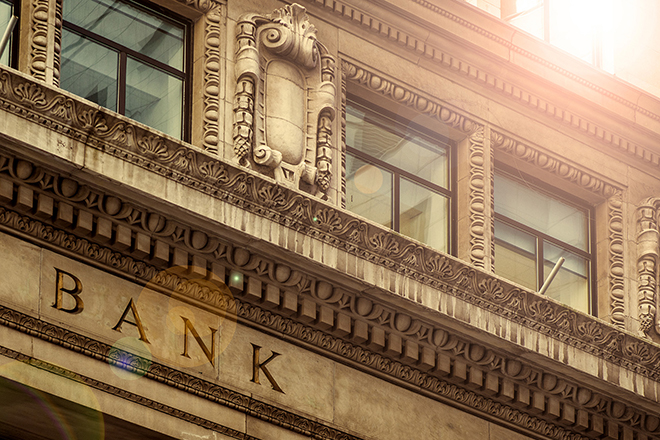Subscribe
Sign up for timely perspectives delivered to your inbox.
Laura Foll, Portfolio Manager of Lowland Investment Company, considers whether concerns about the outlook for the banking sector are overly pessimistic and explains why the Trust has increased its exposure to banks over the last 12 months.

The International Monetary Fund says the outlook for the global economy has “darkened significantly” in recent months. Economists are pointing to inverted yield curves. Central bankers warn they expect to hike interest rates and are prioritising the defeat of inflation over short-term economic well being. Everything seems to suggest imminent global recession. So why have we increased our exposure to banks?
Historically, recessions have been bad news for banks – and their shareholders. This is because most recessions tend to follow periods when economies have overheated. A feature of the dog days of most economic upswings is that banks lend aggressively and even recklessly. The period just before the financial crisis is a great example of this.
When the cycle turns, unemployment shoots up, spending falls and businesses struggle. Then the defaults start to accrue – and bank directors look at their loan books and gulp.
This time it could be different. Governments have encouraged banks to lend throughout the past 12 years of Quantitative Easing (QE), while also constraining them. Banks have shored up their liquidity to meet tighter regulatory demands. They have made lenders meet more challenging stress-test requirements and have limited their lending to earnings ratios.
When Covid struck unexpectedly many of them made provision for significant defaults, expecting the economy to implode. It did not. The government stepped in, offering furlough handouts and loans to companies to keep the economy afloat. The risk associated with these loans is largely on the government’s balance sheet rather than with the banks.
It means many banks are still sitting on the provisions they tucked away in anticipation of economic calamity. They can now fall back on this as a cushion. It is a fortuitous accident of history that they had not got round to unwinding all those provisions before the Ukraine crisis hit.
In the meantime, interest rates are now rising. Though this will eventually hurt some of their customers, it means that for the first time in over a decade banks might start to make a meaningful profit on the difference between the interest they earn on loans and that which they pay out to deposit holders.
Around 40 million consumers have easy-access savings accounts in Britain, according to the Financial Conduct Authority (FCA).2 Since December the Bank of England base rate has been raised five times – from 0.1% to 1.25% – but many major providers are yet to pass on any of this to savers.3 Some pay as little as 0.01%.4 They have not been so slow to pass on mortgage rate rises, though.
While many banks seem to be in strong positions, there are still reasons to be wary. UK inflation hit 9.4% in June – a 40-year high – and some expect it to reach double digits later in the year.5 Household energy costs may rise an additional 40% in the autumn. The cost-of-living crisis is placing a strain on consumers, and we could see an increase in the number of people failing to make loan repayments.
Additionally, the banking sector is vulnerable to disruption. Challenger banks such as Starling and Monzo can offer more efficient, personal online banking experiences. Incumbents must invest in their service proposition and online offerings if they are to retain customers. This investment can often come at the expense of short-term earnings.
Then there is the faint possibility of dividend cuts. During COVID, the FCA forced banks to suspend dividend payments with very little warning – this is still in the very recent past, and it would be natural for shareholders to question whether it could happen again. However, it is likely banks would scale back share buybacks before cutting ordinary dividends. Bar further interference from the FCA, my expectation is that dividends can be held at or grow from current levels.
We have increased our exposure to banks in the past 12 months and hold Lloyds, Barclays, NatWest and HSBC across our portfolios – in our view, it makes sense to be diversified. All four are forecasting a dividend yield of more than 4% over the next year. 6This is an above-market yield – and one we are very comfortable with.
Bank shares have not performed as you might have expected this year, given the rise in interest rates and anticipation of further increases. We have explained why we think concerns regarding bad debt may be overly pessimistic, but this theory could take time to be proved correct (or otherwise). In the meantime, we are being paid a healthy dividend in compensation for our patience.
Inflation – The rate at which the prices of goods and services are rising in an economy. The CPI and RPI are two common measures. The opposite of deflation.
Liquidity – The ability to buy or sell a particular security or asset in the market. Assets that can be easily traded in the market (without causing a major price move) are referred to as ‘liquid’.
Recession – A recession is a significant, widespread, and prolonged downturn in economic activity. Because recessions often last six months or more, one popular rule of thumb is that two consecutive quarters of decline in a country’s Gross Domestic Product (GDP) constitute a recession.
Quantitative Easing – An unconventional monetary policy used by central banks to stimulate the economy by boosting the amount of overall money in the banking system.
Yield curve – A graph that plots the yields of similar quality bonds against their maturities. In a normal/upward sloping yield curve, longer maturity bond yields are higher than short-term bond yields. A yield curve can signal market expectations about a country’s economic direction.